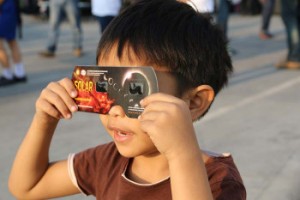
CSP Note: This article was originally posted on CEENTA’s blog. A big thank you to CEENTA for letting us share with our Smarty readers! Happy eclipse day on August 21!
A total solar eclipse is a rare and exciting event, and on August 21, 2017, this part of the country will be lucky enough to experience one. However, even the smallest view of the sun’s rays can cause irreversible damage to your eyes. So before you go out to watch it, make sure you follow a few important steps to keep your eyes safe and healthy.
What happens to the sun?
A solar eclipse is when the moon comes between the sun and the Earth, creating a shadow and blocking light from the sun. A solar eclipse happens every 18 months. A total solar eclipse – when the center of the moon’s shadow hits the Earth when the sun, moon, and Earth are directly in line – is much rarer.
More than 300 million people in the United States could potentially view the solar eclipse. It will last two to three hours, and at the midway point there will be a brief 2 minute and 40 second period when the moon completely blocks the sun’s face, causing a total solar eclipse. Anyone between Charleston, SC, and Salem, Oregon, will be able to see it.
What could happen to my eyes?
For most of the time, however, part of the sun will be exposed, and those rays can permanently burn your eyes. The lens in the eye acts like a magnifying glass. When you look at the sun it focuses light on the retina, damaging the light-sensitive cells with UV radiation. This is called solar retinopathy. Irreversible damage to the retina has been reported in as little as one minute, CEENTA Ophthalmologist F. Scott Sutherland, MD, said.
The only time it is safe to look directly at sun is during the totality. Otherwise, solar eclipse glasses should be worn. However, while it is safe to look at the sun during the totality, doctors still recommend wearing eclipse glasses the whole time.
What are eclipse glasses?
Ordinary sunglasses, even dark ones, are not safe for use during an eclipse. Only specially-designed solar eclipse glasses or handheld solar viewers should be used. Theses glasses must have ISO 12312-2 international standard certification. Homemade filters should not be used. Always inspect your solar glasses or filters, and don’t use them if they are scratched, damaged, or are older than three years.
If you are watching the eclipse with your children, always supervise them. Put their glasses on them and make sure they don’t remove them.
“Young eyes are the most vulnerable because the optics in their eyes are clearer,” Dr. Sutherland said.
What about photos?
If you plan on taking photos, make sure you get a specially-designed solar filter. Solar eclipse glasses are not adequate to protect the camera or your eyes if you look through the camera. It is recommended you seek expert advice from an astronomer before using a solar filter with a camera, telescope, binoculars, or other optical device.
“Prevention of solar retinopathy is the key,” Dr. Sutherland said. “Certified eclipse glasses are widely available for less than $2 to $3, so we encourage people to plan ahead, and not wait until the last minute.”
CEENTA is giving away free eclipse glasses as part of the back-to-school promotion. If you bring your school-age children to any of our 12 optical shops you can get 35 percent off a set of glasses, and we’ll give you eclipse glasses. Please ask any of our opticians for details.
A total solar eclipse is a wonder to behold, and following these steps will ensure it’s a safe experience you’ll talk about positively for years to come.



